|
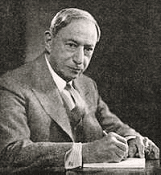 According to
Radio-Electronics magazine editor Hugo Gernsback, some concern was mounting
in the electronics service industry that due to the rapid advancement of
microelectronics - in particular what would eventually be termed "integrated
circuits" - the present day (1962) type of
service technician might no longer be required. Postulated Mr. Gernsback,
"When molecular electronics is mass-produced - which will be soon - it is safe
to assume that, since there are neither mechanically fashioned nor soldered
connections between individual components, and since the total array of the
components is so minute, it will theoretically last for generations." His vision
was that of what we have for the most part today - throw-away electronic
products... According to
Radio-Electronics magazine editor Hugo Gernsback, some concern was mounting
in the electronics service industry that due to the rapid advancement of
microelectronics - in particular what would eventually be termed "integrated
circuits" - the present day (1962) type of
service technician might no longer be required. Postulated Mr. Gernsback,
"When molecular electronics is mass-produced - which will be soon - it is safe
to assume that, since there are neither mechanically fashioned nor soldered
connections between individual components, and since the total array of the
components is so minute, it will theoretically last for generations." His vision
was that of what we have for the most part today - throw-away electronic
products...
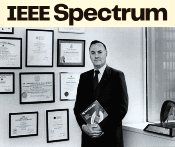 I have always considered IEEE's Spectrum
magazine to be one of the best, and most unbiased electrical engineering magazines
being published. Whereas many (maybe most) bend the knee to woke social and pseudoscience
trends, Spectrum consistently presents solid, objective facts most of the
time. I post links to many of their articles. "This Engineer Became a Star in Technology
Publishing: How Donald Christiansen
Reinvented IEEE Spectrum magazine," was just posted on the IEEE website. It is a
fitting tribute to the man who set the standard for what the magazine has become.
Mr. Christiansen passed away on October 2, 2024, at age 97. RIP. I have always considered IEEE's Spectrum
magazine to be one of the best, and most unbiased electrical engineering magazines
being published. Whereas many (maybe most) bend the knee to woke social and pseudoscience
trends, Spectrum consistently presents solid, objective facts most of the
time. I post links to many of their articles. "This Engineer Became a Star in Technology
Publishing: How Donald Christiansen
Reinvented IEEE Spectrum magazine," was just posted on the IEEE website. It is a
fitting tribute to the man who set the standard for what the magazine has become.
Mr. Christiansen passed away on October 2, 2024, at age 97. RIP.
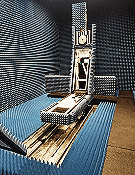 "Near-field measurements are widely recognized
as a highly accurate and versatile technique for testing antennas. The theory behind
these measurements has been known for many decades. In the 1960s, Scientific Atlanta
marketed planar near-field systems where the Fourier transform operation was performed
via operational amplifier circuits. In the 1980s, spherical near-field measurements
were introduced. Today, there are hundreds of near-field antenna test facilities
installed across the globe, attesting to the method's proven effectiveness and significance.
The acceptance of these methods and techniques was the driver behind the creation
of the IEEE Standard 1720, "Recommended
Practice for Near-Field Antenna Measurements..." "Near-field measurements are widely recognized
as a highly accurate and versatile technique for testing antennas. The theory behind
these measurements has been known for many decades. In the 1960s, Scientific Atlanta
marketed planar near-field systems where the Fourier transform operation was performed
via operational amplifier circuits. In the 1980s, spherical near-field measurements
were introduced. Today, there are hundreds of near-field antenna test facilities
installed across the globe, attesting to the method's proven effectiveness and significance.
The acceptance of these methods and techniques was the driver behind the creation
of the IEEE Standard 1720, "Recommended
Practice for Near-Field Antenna Measurements..."
 There are not too many honest-to-goodness
electronics repair shops around anymore - those where the proprietor uses multimeters,
oscilloscopes, and signal generators to troubleshoot and align equipment. In fact,
I would guess that most such shops do most of their business based on customers
who find their services as the result of a Google search. You can find lots of cool
videos of technicians demonstrating (and showing off) their collection of test equipment
and solder rework stations - mostly for fixing vintage audio and video gear. Nowadays
the smartphone screen replacement dude working from a kiosk in the shopping mall
is considered an electronics repairman, which is not... There are not too many honest-to-goodness
electronics repair shops around anymore - those where the proprietor uses multimeters,
oscilloscopes, and signal generators to troubleshoot and align equipment. In fact,
I would guess that most such shops do most of their business based on customers
who find their services as the result of a Google search. You can find lots of cool
videos of technicians demonstrating (and showing off) their collection of test equipment
and solder rework stations - mostly for fixing vintage audio and video gear. Nowadays
the smartphone screen replacement dude working from a kiosk in the shopping mall
is considered an electronics repairman, which is not...
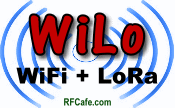 WiLo, a hybrid wireless communications protocol
combining Wi-Fi and Long Range (LoRa) technology, is designed to leverage the strengths
of both systems to provide versatile and energy-efficient connectivity. WiLo emerged
to address the growing demand for a communications standard that could handle both
short-range, high-bandwidth tasks as well as long-range, low-power requirements
- ideal for IoT applications. It integrates the high-speed data transmission capabilities
of Wi-Fi with the long-range, low-power benefits of LoRa, creating a flexible protocol
capable of adapting to a wide range of environments and use cases. The development
of WiLo was a collaborative effort involving multiple organizations, including key... WiLo, a hybrid wireless communications protocol
combining Wi-Fi and Long Range (LoRa) technology, is designed to leverage the strengths
of both systems to provide versatile and energy-efficient connectivity. WiLo emerged
to address the growing demand for a communications standard that could handle both
short-range, high-bandwidth tasks as well as long-range, low-power requirements
- ideal for IoT applications. It integrates the high-speed data transmission capabilities
of Wi-Fi with the long-range, low-power benefits of LoRa, creating a flexible protocol
capable of adapting to a wide range of environments and use cases. The development
of WiLo was a collaborative effort involving multiple organizations, including key...
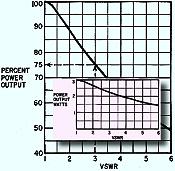 Veterans of the RF communications realm
are well aware of the detrimental effects of not properly impedance matching all
components in a transmit-receive chain. The most common impedance used is 50 Ω
pure resistive (50+j0 Ω) in nature, and when the input and output impedances
are all at that value, power is transmitted without reflection (100% efficient).
Except for optimal power transmission purposes (other impedances optimize values
other than power), any impedance can be used, including those with imaginary parts
(capacitive or inductive). In that case, the requirement for no reflection is that
the load of each stage in the chain be the complex conjugate of the source (i.e.,
if Zsource = R0 + j0 Ω, then Zload = R0 - j0 Ω). This
short feature in a 1966 issue of Radio-Electronics magazine reviews the matter. Veterans of the RF communications realm
are well aware of the detrimental effects of not properly impedance matching all
components in a transmit-receive chain. The most common impedance used is 50 Ω
pure resistive (50+j0 Ω) in nature, and when the input and output impedances
are all at that value, power is transmitted without reflection (100% efficient).
Except for optimal power transmission purposes (other impedances optimize values
other than power), any impedance can be used, including those with imaginary parts
(capacitive or inductive). In that case, the requirement for no reflection is that
the load of each stage in the chain be the complex conjugate of the source (i.e.,
if Zsource = R0 + j0 Ω, then Zload = R0 - j0 Ω). This
short feature in a 1966 issue of Radio-Electronics magazine reviews the matter.
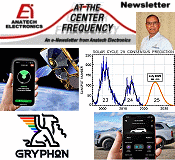 Sam Benzacar, of Anatech Electronics, an
RF and microwave filter company, has published his October 2024 newsletter that,
along with timely news items, features his short op-ed entitled "WiLo
Combines the Best of Wi-Fi and LoRa." His opening statement asserting that WiLo
is so new that there is not even a Wikipedia entry for it yet of course caused me
to immediately verify the veracity of the claim. In fact, there is an entry for
WiLo, but it is not the long new range wireless standard; it is about a company
named Wilo, a European manufacturer of pumps and pump systems for the building technology,
water and industrial sectors. The "WiLo" Sam writes of is a long range wireless
connectivity scheme which combines features of Wi-Fi and LoRA. I took the liberty
of generating an AI-generated description of the WiLo communications... Sam Benzacar, of Anatech Electronics, an
RF and microwave filter company, has published his October 2024 newsletter that,
along with timely news items, features his short op-ed entitled "WiLo
Combines the Best of Wi-Fi and LoRa." His opening statement asserting that WiLo
is so new that there is not even a Wikipedia entry for it yet of course caused me
to immediately verify the veracity of the claim. In fact, there is an entry for
WiLo, but it is not the long new range wireless standard; it is about a company
named Wilo, a European manufacturer of pumps and pump systems for the building technology,
water and industrial sectors. The "WiLo" Sam writes of is a long range wireless
connectivity scheme which combines features of Wi-Fi and LoRA. I took the liberty
of generating an AI-generated description of the WiLo communications...
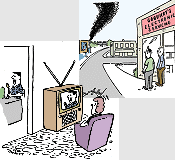 Well, another workweek is underway again
and there's nothing you can do about it. Hunker down for another 40 hours (or more
if you are fortunate enough to be salaried and not have to be paid for overtime)
and prepare to battle the forces that seem to work against you be they electronic
or human. Hopefully, things aren't all that bad, but the potential is always there.
It's commonly known as Murphy's Law: "Whatever can go wrong, will go wrong." It
is said that laughter is the best medicine, some here is a low level inoculation
against what might be in store for the week. These electronics-themed comics appeared
in a 1963 issue... Well, another workweek is underway again
and there's nothing you can do about it. Hunker down for another 40 hours (or more
if you are fortunate enough to be salaried and not have to be paid for overtime)
and prepare to battle the forces that seem to work against you be they electronic
or human. Hopefully, things aren't all that bad, but the potential is always there.
It's commonly known as Murphy's Law: "Whatever can go wrong, will go wrong." It
is said that laughter is the best medicine, some here is a low level inoculation
against what might be in store for the week. These electronics-themed comics appeared
in a 1963 issue...
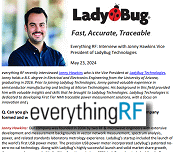 "everything RF recently interviewed
Jonny Hawkins who is the Vice President at LadyBug Technologies. Jonny holds
a B.S. degree in Electrical and Electronics Engineering from the University of Arizona,
graduating in 2016. Prior to joining Ladybug Technologies, Jonny gained valuable
experience in semiconductor manufacturing and testing at Micron Technologies. His
background in this field provided him with valuable insights and skills that he
brought to Ladybug Technologies. Ladybug Technologies is dedicated to developing
First Tier NMI traceable power measurement solutions, with a focus on innovation
and precision. Q: Can you give us a brief history of Ladybug Technologies? Jonny
Hawkins: Our company was founded in 2004 by two RF & microwave engineers with
extensive development..." "everything RF recently interviewed
Jonny Hawkins who is the Vice President at LadyBug Technologies. Jonny holds
a B.S. degree in Electrical and Electronics Engineering from the University of Arizona,
graduating in 2016. Prior to joining Ladybug Technologies, Jonny gained valuable
experience in semiconductor manufacturing and testing at Micron Technologies. His
background in this field provided him with valuable insights and skills that he
brought to Ladybug Technologies. Ladybug Technologies is dedicated to developing
First Tier NMI traceable power measurement solutions, with a focus on innovation
and precision. Q: Can you give us a brief history of Ladybug Technologies? Jonny
Hawkins: Our company was founded in 2004 by two RF & microwave engineers with
extensive development..."
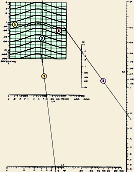 This
nomogram (aka nomograph) provides a simple method for determining the coupling
coefficient (ke) of air core transformers for RF circuits where the operational
wavelength is much longer than the physical length of the transformer. Modern circuit
simulators can calculate such quantities at the blink of an eye, but in 1969 there
was no simple method for doing it. In fact, a lot of design work back in the day
was done using nomograms because given all the impreciseness of circuit layout and
component tolerances, there were enough tunable elements provided to tweak for optimal
performance. Unlike today where the use of sophisticated (and expensive) software
can practically assure first-pass success with circuits into the realm of tens of
GHz, multiple design iterations used to be the norm. As an electronics technician
before earning my BSEE, I built and modified many circuits for the engineers I worked
with before they went into production. We've come a long way, baby. This
nomogram (aka nomograph) provides a simple method for determining the coupling
coefficient (ke) of air core transformers for RF circuits where the operational
wavelength is much longer than the physical length of the transformer. Modern circuit
simulators can calculate such quantities at the blink of an eye, but in 1969 there
was no simple method for doing it. In fact, a lot of design work back in the day
was done using nomograms because given all the impreciseness of circuit layout and
component tolerances, there were enough tunable elements provided to tweak for optimal
performance. Unlike today where the use of sophisticated (and expensive) software
can practically assure first-pass success with circuits into the realm of tens of
GHz, multiple design iterations used to be the norm. As an electronics technician
before earning my BSEE, I built and modified many circuits for the engineers I worked
with before they went into production. We've come a long way, baby.
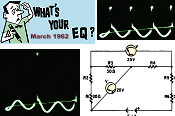 Three more "What's
Your EQ?" challenges were presented in the March 1962 issue of Radio Electronics
magazine. Two were submitted by readers, and one was provided by columnist Jack
Darr. I've said before that I believe Jack is used as a fill-in when not enough
readers provide good content. Jack's circuits always pertain to television, since
that is his column's main topic. The other two should be within the ability of most
RF Cafe visitors to figure out. As I have pointed out in the past, the first thing
to do when a series-parallel circuit is given is to determine whether it can be
redrawn in a manner that results in a more recognizable configuration - like a bridge
or something with symmetry - and rearranging component positions... Three more "What's
Your EQ?" challenges were presented in the March 1962 issue of Radio Electronics
magazine. Two were submitted by readers, and one was provided by columnist Jack
Darr. I've said before that I believe Jack is used as a fill-in when not enough
readers provide good content. Jack's circuits always pertain to television, since
that is his column's main topic. The other two should be within the ability of most
RF Cafe visitors to figure out. As I have pointed out in the past, the first thing
to do when a series-parallel circuit is given is to determine whether it can be
redrawn in a manner that results in a more recognizable configuration - like a bridge
or something with symmetry - and rearranging component positions...
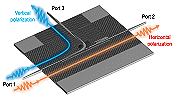 "Researchers in Australia and Japan have
developed a signal mixer that enhances the capacity of terahertz communications.
The mixer, called a
polarization multiplexer, merges two polarized signals of the same frequency
into a single beam and operates at frequencies being explored for future 6G networks.
The all-silicon integrated device uses novel features that deal with some of the
challenges of communicating in the terahertz (THz) spectrum, such as limited power
and transmission range. The researchers report transmitting aggregated data rates..." "Researchers in Australia and Japan have
developed a signal mixer that enhances the capacity of terahertz communications.
The mixer, called a
polarization multiplexer, merges two polarized signals of the same frequency
into a single beam and operates at frequencies being explored for future 6G networks.
The all-silicon integrated device uses novel features that deal with some of the
challenges of communicating in the terahertz (THz) spectrum, such as limited power
and transmission range. The researchers report transmitting aggregated data rates..."
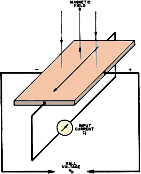 If you do a search on solid state inductors,
you will not find much with a date later than the time when this article appeared
in Electronics World magazine in 1969. It appears a patent was issued in
1965, but the concept seems to never have caught on. The theory and construction
is simple enough according to the information here. Fundamentally, it involves exploiting
the properties of a Hall device when loaded with capacitive or inductive loads to
effect inductive or capacitive properties, respectively. The ability to integrate
capacitive elements into solid state substrates means the current and voltage phase
relationship of an inductor can be obtained in an IC without a physical inductive
element. Evidently practical implementation of
inductors on the die with values greater than a few nanohenries was difficult.
Another option at lower frequencies is to use the gyrator circuit configuration
that employs opamps... If you do a search on solid state inductors,
you will not find much with a date later than the time when this article appeared
in Electronics World magazine in 1969. It appears a patent was issued in
1965, but the concept seems to never have caught on. The theory and construction
is simple enough according to the information here. Fundamentally, it involves exploiting
the properties of a Hall device when loaded with capacitive or inductive loads to
effect inductive or capacitive properties, respectively. The ability to integrate
capacitive elements into solid state substrates means the current and voltage phase
relationship of an inductor can be obtained in an IC without a physical inductive
element. Evidently practical implementation of
inductors on the die with values greater than a few nanohenries was difficult.
Another option at lower frequencies is to use the gyrator circuit configuration
that employs opamps...
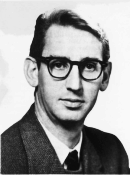 John Battiscombe Gunn, widely known as J.B.
Gunn, was a British physicist and electrical engineer whose groundbreaking research
in semiconductors led to the discovery of the Gunn effect and the invention of the
Gunn diode, a pivotal device in microwave technology. Born in 1928 in Croydon, England,
Gunn spent his early childhood in a modest but intellectually nurturing household.
His father, a civil servant, and his mother, a schoolteacher, both encouraged his
academic curiosity. Although his family was not wealthy, education was highly valued,
and the atmosphere in his home was one of learning and discipline. He grew up alongside
two siblings, both of whom went on to pursue academic careers of their own. As a
child, Gunn showed a marked interest in science, especially... John Battiscombe Gunn, widely known as J.B.
Gunn, was a British physicist and electrical engineer whose groundbreaking research
in semiconductors led to the discovery of the Gunn effect and the invention of the
Gunn diode, a pivotal device in microwave technology. Born in 1928 in Croydon, England,
Gunn spent his early childhood in a modest but intellectually nurturing household.
His father, a civil servant, and his mother, a schoolteacher, both encouraged his
academic curiosity. Although his family was not wealthy, education was highly valued,
and the atmosphere in his home was one of learning and discipline. He grew up alongside
two siblings, both of whom went on to pursue academic careers of their own. As a
child, Gunn showed a marked interest in science, especially...
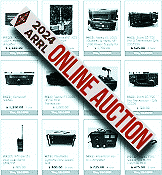 The
19th Annual ARRL Online
Auction sponsored by RT Systems Inc. opened on Friday, October 18, at 10 AM
EDT. The auction continues through Thursday, October 24. This year's auction features
over 200 items and includes ARRL Product Review equipment, vintage books, new donations,
ARRL Lab tested donations, and the ever-popular ARRL Lab "Mystery" boxes. Visit
the auction website, register to bid, and check out details on the items available
so you'll be ready to place a bid on your favorites. Plus, keep an eye on the ARRL
Facebook page and Instagram for featured products and auction highlights throughout
the event... The
19th Annual ARRL Online
Auction sponsored by RT Systems Inc. opened on Friday, October 18, at 10 AM
EDT. The auction continues through Thursday, October 24. This year's auction features
over 200 items and includes ARRL Product Review equipment, vintage books, new donations,
ARRL Lab tested donations, and the ever-popular ARRL Lab "Mystery" boxes. Visit
the auction website, register to bid, and check out details on the items available
so you'll be ready to place a bid on your favorites. Plus, keep an eye on the ARRL
Facebook page and Instagram for featured products and auction highlights throughout
the event...
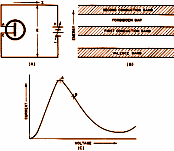 Prior to the advent in 1963 of high frequency
solid state devices like
Gunn diodes, working at or above a couple GHz - even at low power - required
the use of cavity oscillators such as klystrons and magnetrons. They were bulky,
expensive, and electrically very inefficient. This 1969 Electronics World
magazine article outlines the theory of bulk oscillators as developed by Dr. John
A. Copeland, of Bell Labs, and points out the peculiarities of the LSA (limited
space-charge accumulation) mode that makes it possible to obtain 20 milliwatts
of power at 88 GHz. Use of gallium arsenide (GaAs) enabled designers to construct
receiver circuits into the mm-wave region without the need for klystrons, thereby
reducing cost, size, and power requirements... Prior to the advent in 1963 of high frequency
solid state devices like
Gunn diodes, working at or above a couple GHz - even at low power - required
the use of cavity oscillators such as klystrons and magnetrons. They were bulky,
expensive, and electrically very inefficient. This 1969 Electronics World
magazine article outlines the theory of bulk oscillators as developed by Dr. John
A. Copeland, of Bell Labs, and points out the peculiarities of the LSA (limited
space-charge accumulation) mode that makes it possible to obtain 20 milliwatts
of power at 88 GHz. Use of gallium arsenide (GaAs) enabled designers to construct
receiver circuits into the mm-wave region without the need for klystrons, thereby
reducing cost, size, and power requirements...
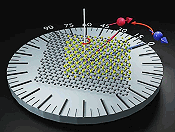 "Researchers have engineered a pioneering
material that harnesses unique spin-related properties by
twisting layers of graphene and tungsten selenide. This innovative technique
in the field of spintronics could revolutionize the development of advanced electronic
devices, enhancing the integration of magnetic memories into processors and overcoming
current limitations in handling spin currents. In conjunction with research staff
from the Charles University of Prague and the CFM (CSIC-UPV/EHU) center in San Sebastian,
CIC nanoGUNE's Nanodevices group has designed a new complex material..." "Researchers have engineered a pioneering
material that harnesses unique spin-related properties by
twisting layers of graphene and tungsten selenide. This innovative technique
in the field of spintronics could revolutionize the development of advanced electronic
devices, enhancing the integration of magnetic memories into processors and overcoming
current limitations in handling spin currents. In conjunction with research staff
from the Charles University of Prague and the CFM (CSIC-UPV/EHU) center in San Sebastian,
CIC nanoGUNE's Nanodevices group has designed a new complex material..."
 The
Institute of Electrical and Electronics Engineers (IEEE) traces its origins
to the late 19th century with the establishment of the American Institute of Electrical
Engineers (AIEE) in 1884, a time when the United States was rapidly industrializing,
and electricity was emerging as a transformative technology. The AIEE was founded
by some of the most notable figures in electrical science and engineering, including
Thomas Edison, Alexander Graham Bell, and others, as a professional organization
dedicated to advancing electrical engineering and promoting the exchange of technical
knowledge. The AIEE focused on the burgeoning fields of telegraphy, electric power...
(be sure to read about the
IEEE logo's meaning) The
Institute of Electrical and Electronics Engineers (IEEE) traces its origins
to the late 19th century with the establishment of the American Institute of Electrical
Engineers (AIEE) in 1884, a time when the United States was rapidly industrializing,
and electricity was emerging as a transformative technology. The AIEE was founded
by some of the most notable figures in electrical science and engineering, including
Thomas Edison, Alexander Graham Bell, and others, as a professional organization
dedicated to advancing electrical engineering and promoting the exchange of technical
knowledge. The AIEE focused on the burgeoning fields of telegraphy, electric power...
(be sure to read about the
IEEE logo's meaning)
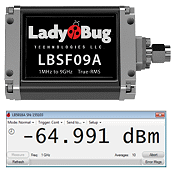 LadyBug Technologies' new
LBSF09A is a true RMS, high sensitivity, high accuracy RF & microwave power
sensor has frequency coverage from 1 MHz to 9 GHz and an 83 dB dynamic
range making ideal for EMC applications, general purpose average power and scalar
measurements. The sensor features a fast measurement speed, a broad dynamic range,
and the widest set of options for programmatic and embedded applications in the
industry. The sensor is useful in research & development, manufacturing &
service applications including radar, satellite, and telecommunications. LadyBug's
PMA-12 Power Meter Software is included with each sensor. The software provides
full control of the sensor's functions from basic setup to triggering, logging,
offset tables, and more. The software package also includes an Interactive IO program
with... LadyBug Technologies' new
LBSF09A is a true RMS, high sensitivity, high accuracy RF & microwave power
sensor has frequency coverage from 1 MHz to 9 GHz and an 83 dB dynamic
range making ideal for EMC applications, general purpose average power and scalar
measurements. The sensor features a fast measurement speed, a broad dynamic range,
and the widest set of options for programmatic and embedded applications in the
industry. The sensor is useful in research & development, manufacturing &
service applications including radar, satellite, and telecommunications. LadyBug's
PMA-12 Power Meter Software is included with each sensor. The software provides
full control of the sensor's functions from basic setup to triggering, logging,
offset tables, and more. The software package also includes an Interactive IO program
with...
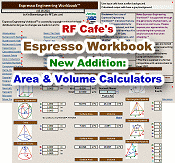 The newest addition to RF Cafe's spreadsheet
(Excel) based engineering and science calculator -
Espresso
Engineering Workbook™ (click to download) is a
collection of surface area and volume calculators for many geometric solids. RF Cafe
Espresso Engineering Workbook™ is provided at no cost, compliments of my generous
sponsors. All of the original calculators from years ago are included, but with
a vastly expanded and improved user interface. Error-trapped user input cells help
prevent entry of invalid values. An extensive use of Visual Basic for Applications
(VBA) functions now do most of the heavy lifting with calculations, and facilitates
a wide user-selectable choice of units for voltage, frequency, speed, temperature,
power... The newest addition to RF Cafe's spreadsheet
(Excel) based engineering and science calculator -
Espresso
Engineering Workbook™ (click to download) is a
collection of surface area and volume calculators for many geometric solids. RF Cafe
Espresso Engineering Workbook™ is provided at no cost, compliments of my generous
sponsors. All of the original calculators from years ago are included, but with
a vastly expanded and improved user interface. Error-trapped user input cells help
prevent entry of invalid values. An extensive use of Visual Basic for Applications
(VBA) functions now do most of the heavy lifting with calculations, and facilitates
a wide user-selectable choice of units for voltage, frequency, speed, temperature,
power...
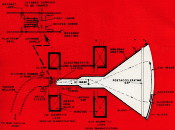 Two somewhat clichéd sayings come to mind
when reading this 1962 Radio-Electronics magazine article on
cathode emission research: "A picture is worth a thousand words," and "settled
science" is only a temporary thing. Author Dr. Aurelius Sandor was in on the
early (1930's) research of cathode rays, having been a (younger) contemporary of
Hans Geiger, of the eponymously named counter fame. Basic assumptions and practices
applied by researchers for two decades inhibited investigations into alternate means
of generating, controlling, and displaying fine detail of millimicron features.
The techniques presented here... Two somewhat clichéd sayings come to mind
when reading this 1962 Radio-Electronics magazine article on
cathode emission research: "A picture is worth a thousand words," and "settled
science" is only a temporary thing. Author Dr. Aurelius Sandor was in on the
early (1930's) research of cathode rays, having been a (younger) contemporary of
Hans Geiger, of the eponymously named counter fame. Basic assumptions and practices
applied by researchers for two decades inhibited investigations into alternate means
of generating, controlling, and displaying fine detail of millimicron features.
The techniques presented here...
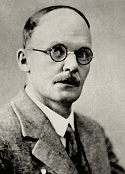 Hans Wilhelm Geiger, born on September 30,
1882, in Neustadt an der Weinstraße, Germany, is best known for inventing the Geiger
counter, a pivotal device in the field of nuclear physics for detecting ionizing
radiation. He grew up in an intellectually stimulating environment, as his father,
Wilhelm Ludwig Geiger, was a prominent philologist and professor at the University
of Erlangen, where he specialized in Indo-European languages. His mother, Hedwig
Geiger (née Höhler), also came from a well-educated family, and together his parents
fostered a household where academic inquiry was highly valued. Geiger's childhood
was marked by a strong sense of discipline and a keen interest in scientific exploration.
He attended secondary school in Erlangen, where his father had taken a professorship,
and developed an early passion for mathematics and physics. This passion guided... Hans Wilhelm Geiger, born on September 30,
1882, in Neustadt an der Weinstraße, Germany, is best known for inventing the Geiger
counter, a pivotal device in the field of nuclear physics for detecting ionizing
radiation. He grew up in an intellectually stimulating environment, as his father,
Wilhelm Ludwig Geiger, was a prominent philologist and professor at the University
of Erlangen, where he specialized in Indo-European languages. His mother, Hedwig
Geiger (née Höhler), also came from a well-educated family, and together his parents
fostered a household where academic inquiry was highly valued. Geiger's childhood
was marked by a strong sense of discipline and a keen interest in scientific exploration.
He attended secondary school in Erlangen, where his father had taken a professorship,
and developed an early passion for mathematics and physics. This passion guided...
• FCC to Refund
Rural 5G Connectivity Program
• NC
Flood Victim Quartz Supplier to Recover in 3 months
• Huawei
Explores Use of 5G RedCap
• Is Intel
Too Big to Fail?
•
ARRL Club Grants Will Be Awarded in November
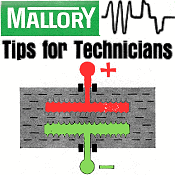 Akin to how the National Company ran a long
series (a couple hundred altogether) of infomercial type ads in the ARRL's QST magazine
from the 1930s through the 1950s, Mallory had its "Tips
for Technicians" run in Electronics World (and maybe other electronics magazines
of the era). Being a major capacitor manufacturer, its ads featured brief tutorials
on various types of capacitors, their characteristics, and how they should be used
in circuits - both for new design and when replacing capacitors in existing equipment... Akin to how the National Company ran a long
series (a couple hundred altogether) of infomercial type ads in the ARRL's QST magazine
from the 1930s through the 1950s, Mallory had its "Tips
for Technicians" run in Electronics World (and maybe other electronics magazines
of the era). Being a major capacitor manufacturer, its ads featured brief tutorials
on various types of capacitors, their characteristics, and how they should be used
in circuits - both for new design and when replacing capacitors in existing equipment...
 Werbel Microwave is a manufacturer of RF
directional and bidirectional couplers (6 dB to 50 dB) and RF power dividers
/ combiners (2- to 16-way) with select models operating up to 26.5 GHz and
100 W of CW power (3 kW peak). All are RoHS and REACH compliant and are
designed and manufactured in our Whippany, NJ, location. Custom products and private
label service available. Please take a couple minutes to visit their website and
see how Werbel Microwave can help you today. Werbel Microwave is a manufacturer of RF
directional and bidirectional couplers (6 dB to 50 dB) and RF power dividers
/ combiners (2- to 16-way) with select models operating up to 26.5 GHz and
100 W of CW power (3 kW peak). All are RoHS and REACH compliant and are
designed and manufactured in our Whippany, NJ, location. Custom products and private
label service available. Please take a couple minutes to visit their website and
see how Werbel Microwave can help you today.
 Charles Babbage, born on December 26, 1791,
in London, England, was one of the foremost mathematicians and inventors of the
19th century, best known for his pioneering work on the concept of a programmable
computer. He was the son of Benjamin Babbage, a banker, and Betsy Plumleigh Teape,
who hailed from a relatively affluent family. His upbringing was comfortable, allowing
him access to an education that would later foster his intellectual pursuits. His
father's wealth enabled Charles to attend some of the finest schools of the time,
although his formal education started somewhat later than usual due to early childhood
illness. Babbage's schooling began at a local academy in Alphington and later at
the King Edward VI Grammar School in Totnes, Devon. He was a highly curious child... Charles Babbage, born on December 26, 1791,
in London, England, was one of the foremost mathematicians and inventors of the
19th century, best known for his pioneering work on the concept of a programmable
computer. He was the son of Benjamin Babbage, a banker, and Betsy Plumleigh Teape,
who hailed from a relatively affluent family. His upbringing was comfortable, allowing
him access to an education that would later foster his intellectual pursuits. His
father's wealth enabled Charles to attend some of the finest schools of the time,
although his formal education started somewhat later than usual due to early childhood
illness. Babbage's schooling began at a local academy in Alphington and later at
the King Edward VI Grammar School in Totnes, Devon. He was a highly curious child...
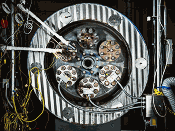 "Yesterday, NASA successfully launched the
Europa Clipper, the largest spacecraft the agency has ever built for a planetary
mission. Clipper is now successfully on its multi-year journey to Europa, bristling
with equipment to study the Jovian moon's potential to support life - but just a
few months ago, the mission was almost doomed. In July, researchers at NASA found
out that a group of Europa Clipper's
transistors would fail under
Jupiter's extreme radiation levels. They spent months testing devices, updating
their flight trajectories, and ultimately adding a warning “canary box” to monitor
the effects of radiation as..." "Yesterday, NASA successfully launched the
Europa Clipper, the largest spacecraft the agency has ever built for a planetary
mission. Clipper is now successfully on its multi-year journey to Europa, bristling
with equipment to study the Jovian moon's potential to support life - but just a
few months ago, the mission was almost doomed. In July, researchers at NASA found
out that a group of Europa Clipper's
transistors would fail under
Jupiter's extreme radiation levels. They spent months testing devices, updating
their flight trajectories, and ultimately adding a warning “canary box” to monitor
the effects of radiation as..."
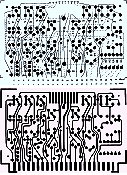 The October issue of Electronics World
magazine included many articles written by
printed circuit board (PCB) industry leaders regarding the state of the art.
Multi-layer PCB technology was still in its infancy at the time, with most prototype
and production boards being 1- or 2-sided. As with the switch from vacuum tubes
to transistors, there were hold-outs who resisted the change to PCBs - for good
reason in some cases. A list of advantages and disadvantages is presented both for
and against, respectively, use of printed circuit boards. One of the biggest advantages
to point-to-point wiring (i.e., in the PCB disadvantage list) was that circuit modifications
in production was more easily accommodated, unless the change was simply... The October issue of Electronics World
magazine included many articles written by
printed circuit board (PCB) industry leaders regarding the state of the art.
Multi-layer PCB technology was still in its infancy at the time, with most prototype
and production boards being 1- or 2-sided. As with the switch from vacuum tubes
to transistors, there were hold-outs who resisted the change to PCBs - for good
reason in some cases. A list of advantages and disadvantages is presented both for
and against, respectively, use of printed circuit boards. One of the biggest advantages
to point-to-point wiring (i.e., in the PCB disadvantage list) was that circuit modifications
in production was more easily accommodated, unless the change was simply...
 Along with the advent of FM (frequency modulation)
radio came an entirely new variety of
antenna shapes and configurations, compared to primarily a simple long, straight
wire for AM (amplitude modulation) radio antennas. Amateur radio operators (Hams)
of course had been designing, tuning, and using such antennas (as FM) for decades,
but the average radio listener was facing a whole new world of options for getting
the most out of his receiver. It is not that AM radio cannot benefit by similar
antenna configurations, it is just that the relatively long wavelength of AM station
frequencies (540 to 1,700 kHz) compared to FM station frequencies (88 to 108 MHz)
represents a two-order-of-magnitude... Along with the advent of FM (frequency modulation)
radio came an entirely new variety of
antenna shapes and configurations, compared to primarily a simple long, straight
wire for AM (amplitude modulation) radio antennas. Amateur radio operators (Hams)
of course had been designing, tuning, and using such antennas (as FM) for decades,
but the average radio listener was facing a whole new world of options for getting
the most out of his receiver. It is not that AM radio cannot benefit by similar
antenna configurations, it is just that the relatively long wavelength of AM station
frequencies (540 to 1,700 kHz) compared to FM station frequencies (88 to 108 MHz)
represents a two-order-of-magnitude...
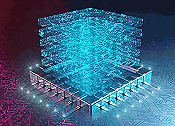 "Researchers have developed a novel
graphene-germanium hot-emitter transistor using a new hot carrier generation
mechanism, achieving unprecedented performance. This advancement opens new possibilities
for low-power, high-performance multifunctional devices. Transistors, the fundamental
components of integrated circuits, encounter increasing difficulties as their size
continues to shrink. To boost circuit performance, it has become essential to develop
transistors that operate on innovative principles. Hot carrier transistors, which
harness the extra kinetic energy of charge carriers, offer the potential to enhance
transistor speed and functionality..." "Researchers have developed a novel
graphene-germanium hot-emitter transistor using a new hot carrier generation
mechanism, achieving unprecedented performance. This advancement opens new possibilities
for low-power, high-performance multifunctional devices. Transistors, the fundamental
components of integrated circuits, encounter increasing difficulties as their size
continues to shrink. To boost circuit performance, it has become essential to develop
transistors that operate on innovative principles. Hot carrier transistors, which
harness the extra kinetic energy of charge carriers, offer the potential to enhance
transistor speed and functionality..."
 When this was originally published, it was
Labor Day in the USA, so most people were off work (which seems antithetical to
the "labor" part of the holiday name). For those unfortunate enough to be at work,
here is a bit of vintage electronic comic relief from a 1969 Electronics World
magazine for your office-bound condition. Actually, during my years of working for
someone else, I used to work the holidays (except Christmas) if I could get another
day off instead. With very few managers around, those of us at work would enjoy
what we termed "IPV," or "In-Plant-Vacation." Very little work got done on those
days, and lunches and break-times were pretty long. I was always surprised the scheme
never caught on more widely... When this was originally published, it was
Labor Day in the USA, so most people were off work (which seems antithetical to
the "labor" part of the holiday name). For those unfortunate enough to be at work,
here is a bit of vintage electronic comic relief from a 1969 Electronics World
magazine for your office-bound condition. Actually, during my years of working for
someone else, I used to work the holidays (except Christmas) if I could get another
day off instead. With very few managers around, those of us at work would enjoy
what we termed "IPV," or "In-Plant-Vacation." Very little work got done on those
days, and lunches and break-times were pretty long. I was always surprised the scheme
never caught on more widely...
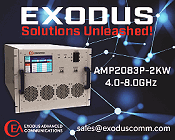 Exodus Advanced Communications, is a multinational
RF communication equipment and engineering service company serving both commercial
and government entities and their affiliates worldwide. We are pleased to announce
the model
AMP2083P-2KW solid state pulse amplifier (SSPA) is designed for Pulse/HIRF,
EMC/EMI Mil-Std 461/464 and radar applications in the C-band, 4.0-8.0 GHz frequency
band. Providing superb pulse fidelity and up to 100 μsec pulse widths. Duty
cycles to 6% with a minimum 63 dB gain. Available monitoring parameters for
Forward/Reflected power in watts & dBm, VSWR, voltage, current, temperature
sensing for outstanding reliability and ruggedness in a compact... Exodus Advanced Communications, is a multinational
RF communication equipment and engineering service company serving both commercial
and government entities and their affiliates worldwide. We are pleased to announce
the model
AMP2083P-2KW solid state pulse amplifier (SSPA) is designed for Pulse/HIRF,
EMC/EMI Mil-Std 461/464 and radar applications in the C-band, 4.0-8.0 GHz frequency
band. Providing superb pulse fidelity and up to 100 μsec pulse widths. Duty
cycles to 6% with a minimum 63 dB gain. Available monitoring parameters for
Forward/Reflected power in watts & dBm, VSWR, voltage, current, temperature
sensing for outstanding reliability and ruggedness in a compact...
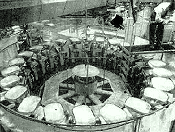 By the time most of us who even remember
cathode ray tubes (CRTs) were first introduced to them, the technology and manufacturing
processes had been pretty much perfected - especially for the standard 525-line
(or 625-line outside the U.S.) resolution type. The National Television System Committee
(NTSC) published a standard for black and white (B&W) television in 1941 and
then for color in 1953. This "Picture Tubes" article in a 1955 issue of Popular
Electronics provides a look inside a CRT manufacturing plant at General Electric.
For some reason the photos in the magazine were very poor quality (maybe for secrecy).
If you want one of the best explanations I have ever seen on how a TV picture scan
is implemented, check out this video entitled
What is 525-Line Analog Video? If you don't understand raster scanning after
watching it, you never will. You might be surprised to learn that there were not
actually 525 lines of picture information... By the time most of us who even remember
cathode ray tubes (CRTs) were first introduced to them, the technology and manufacturing
processes had been pretty much perfected - especially for the standard 525-line
(or 625-line outside the U.S.) resolution type. The National Television System Committee
(NTSC) published a standard for black and white (B&W) television in 1941 and
then for color in 1953. This "Picture Tubes" article in a 1955 issue of Popular
Electronics provides a look inside a CRT manufacturing plant at General Electric.
For some reason the photos in the magazine were very poor quality (maybe for secrecy).
If you want one of the best explanations I have ever seen on how a TV picture scan
is implemented, check out this video entitled
What is 525-Line Analog Video? If you don't understand raster scanning after
watching it, you never will. You might be surprised to learn that there were not
actually 525 lines of picture information...
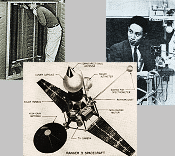 The March 1962 "News Briefs" feature in
Radio-Electronics magazine was chock full of interesting developments.
Space flight was a big deal in the day, not that it isn't today, but the difference
is everything about it was new then. Fundamental technology was in the process of
being developed, and then continual improvements would be made during the ensuing
decades until we get to where we are today with a permanent presence of men in orbit,
interplanetary science probes, space-borne telescopes, Earth environment sensors,
and space weapons, and thousands of active
communications satellites. The sky is awash with manmade objects. In other news,
satellite TV was quickly gaining in capability (including live transmissions and,
gasp, "Living Color" per NBC)... The March 1962 "News Briefs" feature in
Radio-Electronics magazine was chock full of interesting developments.
Space flight was a big deal in the day, not that it isn't today, but the difference
is everything about it was new then. Fundamental technology was in the process of
being developed, and then continual improvements would be made during the ensuing
decades until we get to where we are today with a permanent presence of men in orbit,
interplanetary science probes, space-borne telescopes, Earth environment sensors,
and space weapons, and thousands of active
communications satellites. The sky is awash with manmade objects. In other news,
satellite TV was quickly gaining in capability (including live transmissions and,
gasp, "Living Color" per NBC)...
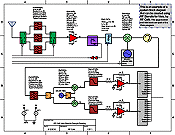 The distinction between
direct conversion, heterodyne, and superheterodyne receivers represents a significant
evolution in radio technology. Each type of receiver plays a crucial role in the
development of modern communications, and their invention marks important milestones
in the history of radio engineering. To understand these differences, we will explore
the invention history, technical descriptions, and practical implementations of
each type, including their inventors, patents, and notable applications. A direct
conversion receiver (also known as a "zero-IF receiver") represents the simplest
type of radio architecture. It was first conceptualized in the early 20th century
as a way to simplify radio designs by eliminating the intermediate frequency (IF)
stage... The distinction between
direct conversion, heterodyne, and superheterodyne receivers represents a significant
evolution in radio technology. Each type of receiver plays a crucial role in the
development of modern communications, and their invention marks important milestones
in the history of radio engineering. To understand these differences, we will explore
the invention history, technical descriptions, and practical implementations of
each type, including their inventors, patents, and notable applications. A direct
conversion receiver (also known as a "zero-IF receiver") represents the simplest
type of radio architecture. It was first conceptualized in the early 20th century
as a way to simplify radio designs by eliminating the intermediate frequency (IF)
stage...
|
 In December of 1931, the discovery of deuterium
(aka "heavy water") was announced by Harold Urey, Japan abandoned the gold standard,
the New York Metropolitan Opera broadcasted an entire opera over radio for the first
time (on Christmas day), and the ARRL's QST magazine published an article
about how to improve a receiver by using a
screen-grid coupling stage on vacuum tubes. A "tickler coil" is introduced via
a tuned circuit to provide a small amount of positive feedback to the grid in order
to make the amplifier stage more sensitive in the band of interest. Care needed
to be taken to avoid so much feedback that oscillations could occur. As with most
of these old articles I post, while the exact application might not be relevant
in today's world of electronics, the basic principles are certainly timeless... In December of 1931, the discovery of deuterium
(aka "heavy water") was announced by Harold Urey, Japan abandoned the gold standard,
the New York Metropolitan Opera broadcasted an entire opera over radio for the first
time (on Christmas day), and the ARRL's QST magazine published an article
about how to improve a receiver by using a
screen-grid coupling stage on vacuum tubes. A "tickler coil" is introduced via
a tuned circuit to provide a small amount of positive feedback to the grid in order
to make the amplifier stage more sensitive in the band of interest. Care needed
to be taken to avoid so much feedback that oscillations could occur. As with most
of these old articles I post, while the exact application might not be relevant
in today's world of electronics, the basic principles are certainly timeless...
 Here are a couple more
electronics-themed comics from a 1940-era issue of Radio News magazine.
The scenarios depicted in these old comics are often based on the real-life experiences
of radio and electronics servicemen. No doubt many guys got clobbered by high voltage
or deafening audio when a customer decided to power up a television or radio while
being worked on in the home. When this comic with the police car radio appeared
in 1940, it had only been a decade since the first 2-way radios were being installed
in patrol cars (see "A New Arm of the Law"). A huge list of technology-themed comics
is listed at the bottom of the page. Enjoy! Here are a couple more
electronics-themed comics from a 1940-era issue of Radio News magazine.
The scenarios depicted in these old comics are often based on the real-life experiences
of radio and electronics servicemen. No doubt many guys got clobbered by high voltage
or deafening audio when a customer decided to power up a television or radio while
being worked on in the home. When this comic with the police car radio appeared
in 1940, it had only been a decade since the first 2-way radios were being installed
in patrol cars (see "A New Arm of the Law"). A huge list of technology-themed comics
is listed at the bottom of the page. Enjoy!
 Today's
ceramic capacitors are vastly different from most of those from
the middle of the last century. While the ceramic capacitor in your modern electronic
circuit is likely in the form of a thin circular or rectangular package, or of a
tiny surface mount outline, those described in this Radio-Electronics magazine
article were rather large tubular devices that had the appearance of a wirewound
power resistor. The advantages of ceramic capacitors over other types available
in the 1950 (paper and mica) are basically the same as today - high voltage handling
and tight tolerances of down to ±1%. Table I lays out a comparison. Wikipedia
has an extensive comparison of modern capacitor types, illustrating how far technology
has advanced since then... Today's
ceramic capacitors are vastly different from most of those from
the middle of the last century. While the ceramic capacitor in your modern electronic
circuit is likely in the form of a thin circular or rectangular package, or of a
tiny surface mount outline, those described in this Radio-Electronics magazine
article were rather large tubular devices that had the appearance of a wirewound
power resistor. The advantages of ceramic capacitors over other types available
in the 1950 (paper and mica) are basically the same as today - high voltage handling
and tight tolerances of down to ±1%. Table I lays out a comparison. Wikipedia
has an extensive comparison of modern capacitor types, illustrating how far technology
has advanced since then...
 It was a lot of work, but I finally finished
a version of the "RF &
Electronics Schematic & Block Diagram Symbols"" that works well with Microsoft
Office™ programs Word™, Excel™, and Power Point™. This is an equivalent of the extensive
set of amplifier, mixer, filter, switch, connector, waveguide, digital, analog,
antenna, and other commonly used symbols for system block diagrams and schematics
created for Visio™. Each of the 1,000+ symbols was exported individually from Visio
in the EMF file format, then imported into Word on a Drawing Canvas. The EMF format
allows an image to be scaled up or down without becoming pixelated, so all the shapes
can be resized in a document and still look good. The imported symbols can also
be UnGrouped into their original constituent parts for editing... It was a lot of work, but I finally finished
a version of the "RF &
Electronics Schematic & Block Diagram Symbols"" that works well with Microsoft
Office™ programs Word™, Excel™, and Power Point™. This is an equivalent of the extensive
set of amplifier, mixer, filter, switch, connector, waveguide, digital, analog,
antenna, and other commonly used symbols for system block diagrams and schematics
created for Visio™. Each of the 1,000+ symbols was exported individually from Visio
in the EMF file format, then imported into Word on a Drawing Canvas. The EMF format
allows an image to be scaled up or down without becoming pixelated, so all the shapes
can be resized in a document and still look good. The imported symbols can also
be UnGrouped into their original constituent parts for editing...
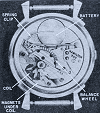 The world's first electric wristwatch went
on sale on January 3, 1957 - the Ventura model, by Hamilton Electric, and it retailed
for $200. I use the event as the theme of the RF Cafe logo for that day in history.
Unlike today's electric watches which use a crystal for timing, the early watches
used a pulsed motor to energize the balance wheel coil, in place of a mainspring
and an escapement mechanism. Some "atomic" wristwatches today like the Casio Waveceptor
(<$40) use the WWV signals from Boulder, Colorado, to synchronize the time with
world standards. The watch shown in this article from the February 1958 edition
of Radio-Electronics magazine is a model 500, which you can find more detail about
on the Unique Watch Guide website... The world's first electric wristwatch went
on sale on January 3, 1957 - the Ventura model, by Hamilton Electric, and it retailed
for $200. I use the event as the theme of the RF Cafe logo for that day in history.
Unlike today's electric watches which use a crystal for timing, the early watches
used a pulsed motor to energize the balance wheel coil, in place of a mainspring
and an escapement mechanism. Some "atomic" wristwatches today like the Casio Waveceptor
(<$40) use the WWV signals from Boulder, Colorado, to synchronize the time with
world standards. The watch shown in this article from the February 1958 edition
of Radio-Electronics magazine is a model 500, which you can find more detail about
on the Unique Watch Guide website...
 One aspect of advertising on the RF Cafe
website I have not covered is using
Google AdSense.
The reason is that I never took the time to explore how - or even whether it is
possible - to target a specific website for displaying your banner ads. A couple
display opportunities have always been provided for Google Ads to display, but the
vast majority of advertising on RF Cafe is done via private advertisers. That is,
companies deal with me directly and I handle inserting their banner ads into the
html page code that randomly selects and displays them. My advertising scheme is
what the industry refers to as a "Tenancy Campaign," whereby a flat price per month
is paid regardless of number of impressions or clicks. It is the simplest format
and has seemed to work well for many companies. With nearly 4 million pageviews
per year for RFCafe.com, the average impression rate per banner ad is about 225,000k per
year (in eight locations on each page, with >17k pages)... One aspect of advertising on the RF Cafe
website I have not covered is using
Google AdSense.
The reason is that I never took the time to explore how - or even whether it is
possible - to target a specific website for displaying your banner ads. A couple
display opportunities have always been provided for Google Ads to display, but the
vast majority of advertising on RF Cafe is done via private advertisers. That is,
companies deal with me directly and I handle inserting their banner ads into the
html page code that randomly selects and displays them. My advertising scheme is
what the industry refers to as a "Tenancy Campaign," whereby a flat price per month
is paid regardless of number of impressions or clicks. It is the simplest format
and has seemed to work well for many companies. With nearly 4 million pageviews
per year for RFCafe.com, the average impression rate per banner ad is about 225,000k per
year (in eight locations on each page, with >17k pages)...
 RACEP (Random Access and Correlation for Extended
Performance), was an early form of frequency hopping spread spectrum (HFSS)
devised by the Martin Company (now Lockheed-Martin). It was used for secure voice
communications and worked by sampling speech in small 'slices' and then transmitting
each slice modulated onto a carrier whose frequency was determined by a predetermined
sequence of center frequencies. A receiver with a matching sequence key would then
decode the speech and, with appropriate filtering, reassemble it into its original
content. President John F. Kennedy had such systems at his disposal whether on the
road or in the Oval Office. General Electric (GE) had a different idea it dubbed
'Phantom' that spread the signal over a very wide bandwidth. Today, we refer to
it as Direct Sequence Spread Spectrum (DSSS) ... RACEP (Random Access and Correlation for Extended
Performance), was an early form of frequency hopping spread spectrum (HFSS)
devised by the Martin Company (now Lockheed-Martin). It was used for secure voice
communications and worked by sampling speech in small 'slices' and then transmitting
each slice modulated onto a carrier whose frequency was determined by a predetermined
sequence of center frequencies. A receiver with a matching sequence key would then
decode the speech and, with appropriate filtering, reassemble it into its original
content. President John F. Kennedy had such systems at his disposal whether on the
road or in the Oval Office. General Electric (GE) had a different idea it dubbed
'Phantom' that spread the signal over a very wide bandwidth. Today, we refer to
it as Direct Sequence Spread Spectrum (DSSS) ...
 An alternate title for this article that
appeared in a 1969 issue of Radio-Electronics magazine could have been,
"How
to Build a J-K Flip-Flop." Author Leonard Geisler takes the reader through a
step-by-step assembly of a functional J-K flip-flop using a collection of 1- 2-
and 3-input NAND gates. The 1-input NAND, in case you are wondering, is used as
an inverter. The piece reads like an in-depth first-semester electrical engineering
technician course textbook. In the process of building the J-K, an R-S (reset/set)
flip-flop is described. Nowhere does Geisler offer an explanation of from where
the "J" and the "K" input labels come. According to electrical engineer Sourav
Bhattacharya blog, it was Dr. Eldred Nelson of Hughes Aircraft who first coined
the term J-K flip-flop... An alternate title for this article that
appeared in a 1969 issue of Radio-Electronics magazine could have been,
"How
to Build a J-K Flip-Flop." Author Leonard Geisler takes the reader through a
step-by-step assembly of a functional J-K flip-flop using a collection of 1- 2-
and 3-input NAND gates. The 1-input NAND, in case you are wondering, is used as
an inverter. The piece reads like an in-depth first-semester electrical engineering
technician course textbook. In the process of building the J-K, an R-S (reset/set)
flip-flop is described. Nowhere does Geisler offer an explanation of from where
the "J" and the "K" input labels come. According to electrical engineer Sourav
Bhattacharya blog, it was Dr. Eldred Nelson of Hughes Aircraft who first coined
the term J-K flip-flop...
 "Ignitron"
sounds like a contemporary pejorative term for someone who blindly follows orders.
In the 1940s, though, it was a type of steel-jacketed vacuum tube manufactured by
General Electric for use in conversion from alternating alternating to direct current
(AC-DC) power supplies. According to this GE document, "Ignitrons are gas-discharge,
pool-type cathode tubes in which the arc is started for each conducting cycle by
means of a starting or ignition electrode. The tubes are of the half-wave type in
which the current is carried through the tube during only the positive part of the
cycle. During the remainder or non-conducting part the residual ionization reaches
very low values in comparison with the ionization present in the multi-anode type
of pool tube where it is proportional to the load current carried. As a result of
the so-called dark, negative half-cycle, the shielding required in half-wave tubes
is greatly reduced from that in the multi-anode tube. Reduction in shielding in
turn lowers the arc voltages so that tubes of this type may be efficiently applied... "Ignitron"
sounds like a contemporary pejorative term for someone who blindly follows orders.
In the 1940s, though, it was a type of steel-jacketed vacuum tube manufactured by
General Electric for use in conversion from alternating alternating to direct current
(AC-DC) power supplies. According to this GE document, "Ignitrons are gas-discharge,
pool-type cathode tubes in which the arc is started for each conducting cycle by
means of a starting or ignition electrode. The tubes are of the half-wave type in
which the current is carried through the tube during only the positive part of the
cycle. During the remainder or non-conducting part the residual ionization reaches
very low values in comparison with the ionization present in the multi-anode type
of pool tube where it is proportional to the load current carried. As a result of
the so-called dark, negative half-cycle, the shielding required in half-wave tubes
is greatly reduced from that in the multi-anode tube. Reduction in shielding in
turn lowers the arc voltages so that tubes of this type may be efficiently applied...
 Some day in the not too distant future, a generation
of electronics enthusiasts will read magazines like Nuts & Volts, QST,
Make, and other hobbyist publications and be amazed at how crude our present
day methods for building
homebrew projects were. They might even feel sorry for us. Having digital cameras,
sophisticated graphics software, high resolution inkjet and laser printers, and vinyl
cutting machines for adorning chassis and panels are a godsend here in twenty-teens compared
to the film-based analog cameras, chemical-based photo processing labs, and rub-on lettering
and shape stencils... Some day in the not too distant future, a generation
of electronics enthusiasts will read magazines like Nuts & Volts, QST,
Make, and other hobbyist publications and be amazed at how crude our present
day methods for building
homebrew projects were. They might even feel sorry for us. Having digital cameras,
sophisticated graphics software, high resolution inkjet and laser printers, and vinyl
cutting machines for adorning chassis and panels are a godsend here in twenty-teens compared
to the film-based analog cameras, chemical-based photo processing labs, and rub-on lettering
and shape stencils...
 By 1962, John T. Frye's techie troubleshooting
teenagers
Carl and Jerry had graduated from high school and were attending Parvoo University
(PU?) as electrical engineering students. It was a natural progression. Unlike many
of the company names and products - like the Delco DN278 transistor mentioned here
- that appeared in the Popular Science series, the college's name is fictional.
Maybe author Frye had a connection to Porvoo, Finland, and Anglicized the name.
Per RF Cafe visitor Jim P., "The stadium in the story is Moss-Ade stadium.
The stadium at Purdue University is Ross-Ade stadium. I would guess that Parvoo
comes from Purdue." According to a search I did to determine whether Frye ever attended
Purdue, "Remarkably enough, he never attended Purdue University..." By 1962, John T. Frye's techie troubleshooting
teenagers
Carl and Jerry had graduated from high school and were attending Parvoo University
(PU?) as electrical engineering students. It was a natural progression. Unlike many
of the company names and products - like the Delco DN278 transistor mentioned here
- that appeared in the Popular Science series, the college's name is fictional.
Maybe author Frye had a connection to Porvoo, Finland, and Anglicized the name.
Per RF Cafe visitor Jim P., "The stadium in the story is Moss-Ade stadium.
The stadium at Purdue University is Ross-Ade stadium. I would guess that Parvoo
comes from Purdue." According to a search I did to determine whether Frye ever attended
Purdue, "Remarkably enough, he never attended Purdue University..."
 Unlike many electronics enthusiasts including
hobbyists, salesmen, servicemen, and commercial and domestic users, Mac McGregor
was an early-on believer of the ultimate replacement of vacuum tubes by transistors.
Only a decade old and not yet adopted by a lot of manufacturers (to their ultimate
demise in some cases),
transistors were fighting a major battle to gain acceptance and trust by the
public. Not only were transistors still more expensive than an equivalent vacuum
tube, but the reliability was not as good - most times due to designers not properly
accounting for their special needs for protection against voltage extremes. Once
the price of transistorized products fell into parity with their predecessors, consumers
quickly adopted the products because of the markedly smaller sizes and lower power
consumption... Unlike many electronics enthusiasts including
hobbyists, salesmen, servicemen, and commercial and domestic users, Mac McGregor
was an early-on believer of the ultimate replacement of vacuum tubes by transistors.
Only a decade old and not yet adopted by a lot of manufacturers (to their ultimate
demise in some cases),
transistors were fighting a major battle to gain acceptance and trust by the
public. Not only were transistors still more expensive than an equivalent vacuum
tube, but the reliability was not as good - most times due to designers not properly
accounting for their special needs for protection against voltage extremes. Once
the price of transistorized products fell into parity with their predecessors, consumers
quickly adopted the products because of the markedly smaller sizes and lower power
consumption...
 Only a couple decades prior to when this
article on a newfangled
wireless automatic garage door opener appeared in Radio-Craft
magazine, there would have been no demand for such a device ... although maybe an
automatic horse barn door opener would have been in demand if a battery was available
on the coach. Amazingly, the system employed an early, albeit crude, form of both
spread spectrum and digital communications in order to trigger the receiver for
opening the door. The spread spectrum characteristic of the signal was the natural
consequence of using a spark transmitter. A digital 'Morse' code encryption allowed
multiple openers to be installed in close proximity. The opener did not have any
type of safety sensor to prevent people or things from being crushed, but then it
wasn't until sometime around the 1970s that the feature became standard... Only a couple decades prior to when this
article on a newfangled
wireless automatic garage door opener appeared in Radio-Craft
magazine, there would have been no demand for such a device ... although maybe an
automatic horse barn door opener would have been in demand if a battery was available
on the coach. Amazingly, the system employed an early, albeit crude, form of both
spread spectrum and digital communications in order to trigger the receiver for
opening the door. The spread spectrum characteristic of the signal was the natural
consequence of using a spark transmitter. A digital 'Morse' code encryption allowed
multiple openers to be installed in close proximity. The opener did not have any
type of safety sensor to prevent people or things from being crushed, but then it
wasn't until sometime around the 1970s that the feature became standard...
 It was a lot of work, but I finally finished
a version of the "RF &
Electronics Schematic & Block Diagram Symbols"" that works well with Microsoft
Office™ programs Word™, Excel™, and Power Point™. This is an equivalent of the extensive
set of amplifier, mixer, filter, switch, connector, waveguide, digital, analog,
antenna, and other commonly used symbols for system block diagrams and schematics
created for Visio™. Each of the 1,000+ symbols was exported individually from Visio
in the EMF file format, then imported into Word on a Drawing Canvas. The EMF format
allows an image to be scaled up or down without becoming pixelated, so all the shapes
can be resized in a document and still look good. The imported symbols can also
be UnGrouped into their original constituent parts for editing... It was a lot of work, but I finally finished
a version of the "RF &
Electronics Schematic & Block Diagram Symbols"" that works well with Microsoft
Office™ programs Word™, Excel™, and Power Point™. This is an equivalent of the extensive
set of amplifier, mixer, filter, switch, connector, waveguide, digital, analog,
antenna, and other commonly used symbols for system block diagrams and schematics
created for Visio™. Each of the 1,000+ symbols was exported individually from Visio
in the EMF file format, then imported into Word on a Drawing Canvas. The EMF format
allows an image to be scaled up or down without becoming pixelated, so all the shapes
can be resized in a document and still look good. The imported symbols can also
be UnGrouped into their original constituent parts for editing...
 One aspect of advertising on the RF Cafe
website I have not covered is using
Google AdSense.
The reason is that I never took the time to explore how - or even whether it is
possible - to target a specific website for displaying your banner ads. A couple
display opportunities have always been provided for Google Ads to display, but the
vast majority of advertising on RF Cafe is done via private advertisers. That is,
companies deal with me directly and I handle inserting their banner ads into the
html page code that randomly selects and displays them. My advertising scheme is
what the industry refers to as a "Tenancy Campaign," whereby a flat price per month
is paid regardless of number of impressions or clicks. It is the simplest format
and has seemed to work well for many companies. With nearly 4 million pageviews
per year for RFCafe.com, the average impression rate per banner ad is about 225,000k per
year (in eight locations on each page, with >17k pages)... One aspect of advertising on the RF Cafe
website I have not covered is using
Google AdSense.
The reason is that I never took the time to explore how - or even whether it is
possible - to target a specific website for displaying your banner ads. A couple
display opportunities have always been provided for Google Ads to display, but the
vast majority of advertising on RF Cafe is done via private advertisers. That is,
companies deal with me directly and I handle inserting their banner ads into the
html page code that randomly selects and displays them. My advertising scheme is
what the industry refers to as a "Tenancy Campaign," whereby a flat price per month
is paid regardless of number of impressions or clicks. It is the simplest format
and has seemed to work well for many companies. With nearly 4 million pageviews
per year for RFCafe.com, the average impression rate per banner ad is about 225,000k per
year (in eight locations on each page, with >17k pages)...
 Radio-controlled flying drones are commonplace
today - so much so that the FAA has enacted legislation to strictly limit who can
fly them, where they can be flown, how big they can be, what type of payloads can
be carried, how far from the pilot they can be flown, etc. - the typical kind of
overreaching and overregulating that governments promulgate (especially in the last
few years). Sport model airplane flying has suffered loss of freedoms because of
it by getting lumped in with multirotor drones. The military, of course, has been
using radio-controlled drones for decades, as highlighted in this 1945 Radio-Craft
magazine article. Author Louis Bruchiss extolls the advantages of being able to
guide an ordinance payload after being released from an aircraft of after being
launched from the ground. Even vehicles like the German V-2 rocket with its gyroscopically
stabilized guidance... Radio-controlled flying drones are commonplace
today - so much so that the FAA has enacted legislation to strictly limit who can
fly them, where they can be flown, how big they can be, what type of payloads can
be carried, how far from the pilot they can be flown, etc. - the typical kind of
overreaching and overregulating that governments promulgate (especially in the last
few years). Sport model airplane flying has suffered loss of freedoms because of
it by getting lumped in with multirotor drones. The military, of course, has been
using radio-controlled drones for decades, as highlighted in this 1945 Radio-Craft
magazine article. Author Louis Bruchiss extolls the advantages of being able to
guide an ordinance payload after being released from an aircraft of after being
launched from the ground. Even vehicles like the German V-2 rocket with its gyroscopically
stabilized guidance...
 This
passive
limiter is a simple combination of cascaded "T" type resistive attenuators that
are switched in and out of the circuit based on the power level in the line. The
design takes a bit of thinking due to needing to retain a reasonable impedance match
at the input and output throughout various stages' conduction states. Arriving at
an optimal value for resistors would require a circuit simulator with a mathematically
based optimizer, but, especially for amateur radio work, close is good enough. That
is not to say Hams are a bunch of slackers - they're not - it's just that component
and software resources are not as readily available (aka "prohibitively expensive")
for doing the analysis and testing. In 1966 when this article was published, software
did not even exist for people without access to university or corporate computers.
For most users these days, it is cheaper to buy a limiter for 2- to 3-score dollars... This
passive
limiter is a simple combination of cascaded "T" type resistive attenuators that
are switched in and out of the circuit based on the power level in the line. The
design takes a bit of thinking due to needing to retain a reasonable impedance match
at the input and output throughout various stages' conduction states. Arriving at
an optimal value for resistors would require a circuit simulator with a mathematically
based optimizer, but, especially for amateur radio work, close is good enough. That
is not to say Hams are a bunch of slackers - they're not - it's just that component
and software resources are not as readily available (aka "prohibitively expensive")
for doing the analysis and testing. In 1966 when this article was published, software
did not even exist for people without access to university or corporate computers.
For most users these days, it is cheaper to buy a limiter for 2- to 3-score dollars...
 Even if you are not, never were, and don't
plan to be a color television serviceman, this installment of
Mac's Service Shop that appeared in a 1973 issue of Popular
Electronics provides an interesting insight into the manner in which the
electronics industry was rapidly changing in the 1970s. By 1973 most
manufacturers had fully committed to all solid state circuitry (except for the
CRT, of course), and the competition was focusing on customer satisfaction.
Point-to-point wiring of chassis with leaded resistors, capacitors, inductors,
and interconnecting wires and coaxial cable gave way to multiple printed circuit
boards (PCBs) with a maze of interconnecting wire harnesses. In theory the
scheme was much more reliable and serviceable, and for the most part it was. The
problem was that a lot of service guys were still struggling to come up to speed
on the newfangled technology. Trying to use a 500 watt soldering iron... Even if you are not, never were, and don't
plan to be a color television serviceman, this installment of
Mac's Service Shop that appeared in a 1973 issue of Popular
Electronics provides an interesting insight into the manner in which the
electronics industry was rapidly changing in the 1970s. By 1973 most
manufacturers had fully committed to all solid state circuitry (except for the
CRT, of course), and the competition was focusing on customer satisfaction.
Point-to-point wiring of chassis with leaded resistors, capacitors, inductors,
and interconnecting wires and coaxial cable gave way to multiple printed circuit
boards (PCBs) with a maze of interconnecting wire harnesses. In theory the
scheme was much more reliable and serviceable, and for the most part it was. The
problem was that a lot of service guys were still struggling to come up to speed
on the newfangled technology. Trying to use a 500 watt soldering iron...
 Electronics wizard, repairman, and experimenter
extraordinaire Mac McGregor, as sort of alter ego of author John T. Frye, provides
a brief lesson on electrostatics for his repair shop apprentice wing man Barney
(I don't think his last name was ever mentioned). In this 1973 Popular Electronics
magazine article, Mac had built two types of
electroscopes - one using a pair of pith balls suspended from silk strings and
another that was a cobbled-together version of a gold leaf electroscope. His motive
was two-fold. First and foremost was to accommodate his own interest in electrostatics,
and second to hopefully engender enough curiosity in Barney to cause him to do a
dive into science books to learn more. Given the potentially lethal levels of electrostatic
charge that builds on TV picture tubes they worked around, gaining a healthy respect
for an electrostatic charge... Electronics wizard, repairman, and experimenter
extraordinaire Mac McGregor, as sort of alter ego of author John T. Frye, provides
a brief lesson on electrostatics for his repair shop apprentice wing man Barney
(I don't think his last name was ever mentioned). In this 1973 Popular Electronics
magazine article, Mac had built two types of
electroscopes - one using a pair of pith balls suspended from silk strings and
another that was a cobbled-together version of a gold leaf electroscope. His motive
was two-fold. First and foremost was to accommodate his own interest in electrostatics,
and second to hopefully engender enough curiosity in Barney to cause him to do a
dive into science books to learn more. Given the potentially lethal levels of electrostatic
charge that builds on TV picture tubes they worked around, gaining a healthy respect
for an electrostatic charge...
 After discussing the virtue of not letting
someone else's opinion on the likely cause of a problem direct your own actions
when troubleshooting, service shop proprietor Mac McGregor asks Barney about issues
he has run into related to the area's having recently had television channel 13
broadcasting added to the area. When he mentions the trouble cause by homeowners
leaving excess lengths of
twin-lead 300 Ω lead-in wire coiled up behind the TV set, it brought to
mind my own mentioning a couple days ago that very scenario in comments made on
the "A Two-Band Piece of Wire" article. You and I would be tempted to criticize
people for making such an "obvious" mistake, but most people then - and now - have
no knowledge of the particulars of routing such cable. A switchover to coaxial cable
with the advent of cable TV removed most of the need for being concerned over installation,
other than assuring tight connects, proper terminations, and keeping cable length
as short as possible to minimize signal loss. Other than that, properly shielded... After discussing the virtue of not letting
someone else's opinion on the likely cause of a problem direct your own actions
when troubleshooting, service shop proprietor Mac McGregor asks Barney about issues
he has run into related to the area's having recently had television channel 13
broadcasting added to the area. When he mentions the trouble cause by homeowners
leaving excess lengths of
twin-lead 300 Ω lead-in wire coiled up behind the TV set, it brought to
mind my own mentioning a couple days ago that very scenario in comments made on
the "A Two-Band Piece of Wire" article. You and I would be tempted to criticize
people for making such an "obvious" mistake, but most people then - and now - have
no knowledge of the particulars of routing such cable. A switchover to coaxial cable
with the advent of cable TV removed most of the need for being concerned over installation,
other than assuring tight connects, proper terminations, and keeping cable length
as short as possible to minimize signal loss. Other than that, properly shielded...
 One aspect of advertising on the RF Cafe
website I have not covered is using
Google AdSense.
The reason is that I never took the time to explore how - or even whether it is
possible - to target a specific website for displaying your banner ads. A couple
display opportunities have always been provided for Google Ads to display, but the
vast majority of advertising on RF Cafe is done via private advertisers. That is,
companies deal with me directly and I handle inserting their banner ads into the
html page code that randomly selects and displays them. My advertising scheme is
what the industry refers to as a "Tenancy Campaign," whereby a flat price per month
is paid regardless of number of impressions or clicks. It is the simplest format
and has seemed to work well for many companies. With nearly 4 million pageviews
per year for RFCafe.com, the average impression rate per banner ad is about 225,000k per
year (in eight locations on each page, with >17k pages)... One aspect of advertising on the RF Cafe
website I have not covered is using
Google AdSense.
The reason is that I never took the time to explore how - or even whether it is
possible - to target a specific website for displaying your banner ads. A couple
display opportunities have always been provided for Google Ads to display, but the
vast majority of advertising on RF Cafe is done via private advertisers. That is,
companies deal with me directly and I handle inserting their banner ads into the
html page code that randomly selects and displays them. My advertising scheme is
what the industry refers to as a "Tenancy Campaign," whereby a flat price per month
is paid regardless of number of impressions or clicks. It is the simplest format
and has seemed to work well for many companies. With nearly 4 million pageviews
per year for RFCafe.com, the average impression rate per banner ad is about 225,000k per
year (in eight locations on each page, with >17k pages)...
 I checked out the printed circuit board maze
and, as implied, all those beginning paths lead to $. RCA (Radio
Corporation of America), along with other companies like NRI (National Radio Institute),
CIE (Cleveland Institute of Electronics, all had a unique angle. Every company attempts
to pique interest in its products and/or service by creating buzzwords such as,
in RCA's case,
AUTOTEXT. AUTOTEXT is "a system of programmed instructions, a
method of learning proved with thousands of students. This beginning source in electronics
is accurately planned so that as you read a series of statements, questions, and
answers, you learn almost without realizing it. It's fast! It's easy! It's fun!"
Learning by osmosis. What more could an aspiring technician ask for?... I checked out the printed circuit board maze
and, as implied, all those beginning paths lead to $. RCA (Radio
Corporation of America), along with other companies like NRI (National Radio Institute),
CIE (Cleveland Institute of Electronics, all had a unique angle. Every company attempts
to pique interest in its products and/or service by creating buzzwords such as,
in RCA's case,
AUTOTEXT. AUTOTEXT is "a system of programmed instructions, a
method of learning proved with thousands of students. This beginning source in electronics
is accurately planned so that as you read a series of statements, questions, and
answers, you learn almost without realizing it. It's fast! It's easy! It's fun!"
Learning by osmosis. What more could an aspiring technician ask for?...
 The
RCA Victor Model C9-4 is a 9-tube, 3-band superheterodyne console
model radio made in the mid 1930s. A Radio Service Data Sheet for it appeared in
the January 1936 issue of Radio-Craft magazine. The image of the radio
was found on the RadioMuseum.org website. FM broadcasting was not in common use
yet, so only AM bands and some shortwave bands were available. In fact, 1936 was
the year that frequency modulation (FM) inventor Edwin H. Armstrong first
demonstrated his newfangled concept that largely solved the electrical static
noise problem cause by lightning, motor brushes, arcing overhead power lines... The
RCA Victor Model C9-4 is a 9-tube, 3-band superheterodyne console
model radio made in the mid 1930s. A Radio Service Data Sheet for it appeared in
the January 1936 issue of Radio-Craft magazine. The image of the radio
was found on the RadioMuseum.org website. FM broadcasting was not in common use
yet, so only AM bands and some shortwave bands were available. In fact, 1936 was
the year that frequency modulation (FM) inventor Edwin H. Armstrong first
demonstrated his newfangled concept that largely solved the electrical static
noise problem cause by lightning, motor brushes, arcing overhead power lines...
 Magnetostriction is a term not seen very
often these days. It describes the physical shape change that takes place in certain
ferrous materials when subject to a magnetic field, and is responsible for most
of the familiar "hum" that comes from transformers (the other part comes from attracting
and opposing fields rattling windings). The effect is used in mechanical filters
as transducers between the electronic circuit and the mechanically resonant disks
that define filter bandpass characteristics. Elemental cobalt exhibits the highest
room temperature magnetostriction (units are "microstrains"). Nickel, with about
half the value as cobalt, is cheaper and more abundant and is therefor more commonly
used in modern magnetorestrictive transducers. Way back in the 1980s while working
at the Oceanic Division of Westinghouse Electric, in Annapolis, MD, I built sonar
transducer arrays... Magnetostriction is a term not seen very
often these days. It describes the physical shape change that takes place in certain
ferrous materials when subject to a magnetic field, and is responsible for most
of the familiar "hum" that comes from transformers (the other part comes from attracting
and opposing fields rattling windings). The effect is used in mechanical filters
as transducers between the electronic circuit and the mechanically resonant disks
that define filter bandpass characteristics. Elemental cobalt exhibits the highest
room temperature magnetostriction (units are "microstrains"). Nickel, with about
half the value as cobalt, is cheaper and more abundant and is therefor more commonly
used in modern magnetorestrictive transducers. Way back in the 1980s while working
at the Oceanic Division of Westinghouse Electric, in Annapolis, MD, I built sonar
transducer arrays...
 With more than 1000
custom-built stencils, this has got to be the most comprehensive set of
Visio Stencils
available for RF, analog, and digital system and schematic drawings! Every stencil
symbol has been built to fit proportionally on the included A-, B-, and C-size drawing
page templates (or use your own page if preferred). Components are provided for
system block diagrams, conceptual drawings, schematics, test equipment, racks, and
more. Page templates are provided with a preset scale (changeable) for a good presentation
that can incorporate all provided symbols... With more than 1000
custom-built stencils, this has got to be the most comprehensive set of
Visio Stencils
available for RF, analog, and digital system and schematic drawings! Every stencil
symbol has been built to fit proportionally on the included A-, B-, and C-size drawing
page templates (or use your own page if preferred). Components are provided for
system block diagrams, conceptual drawings, schematics, test equipment, racks, and
more. Page templates are provided with a preset scale (changeable) for a good presentation
that can incorporate all provided symbols...
 This is a different type of
electronics-related quiz from Quizmaster Robert P. Balin. Mr. Balin
created many monthly quizzes for Popular Electronics magazine. Here you
are provided a series of images and a list of men's first names, and you need to
match the image to the name. There are nine in all. Sure, it's kind of hokey (especially
B and I), but it is a good Friday afternoon challenge to help pass the time until
the weekend begins. Enjoy. This is a different type of
electronics-related quiz from Quizmaster Robert P. Balin. Mr. Balin
created many monthly quizzes for Popular Electronics magazine. Here you
are provided a series of images and a list of men's first names, and you need to
match the image to the name. There are nine in all. Sure, it's kind of hokey (especially
B and I), but it is a good Friday afternoon challenge to help pass the time until
the weekend begins. Enjoy.
 For some inexplicable reason, the first page
of Part 1 of the "Electric
Space Ships" articles in Radio-Electronics magazine is nowhere to be found.
It is missing from the scanned copy, so I am attempting to get a hard copy on eBay
(December 1950 issue). Until then, here is what is available from the PDF version
on the WorldRadioHistory website (I normally only use my own purchased hard copies).
One RF Cafe visitor wrote when I originally posted Part 2 that he has searched
in vain for the missing portion of Part 1 and thinks there might be some kind
of conspiracy to hide the information - part of the ET/UFO cover-up. Maybe the government
has gone around and ripped page 32 from every issue of the magazine ;-) Otherwise,
note in Figure 2 the "electric wind" affecting the candle flame. This flame-related
phenomenon is likely the principle which Lee deForest exploited in his early radio
signal detectors which, eventually, led to his Audion invention... For some inexplicable reason, the first page
of Part 1 of the "Electric
Space Ships" articles in Radio-Electronics magazine is nowhere to be found.
It is missing from the scanned copy, so I am attempting to get a hard copy on eBay
(December 1950 issue). Until then, here is what is available from the PDF version
on the WorldRadioHistory website (I normally only use my own purchased hard copies).
One RF Cafe visitor wrote when I originally posted Part 2 that he has searched
in vain for the missing portion of Part 1 and thinks there might be some kind
of conspiracy to hide the information - part of the ET/UFO cover-up. Maybe the government
has gone around and ripped page 32 from every issue of the magazine ;-) Otherwise,
note in Figure 2 the "electric wind" affecting the candle flame. This flame-related
phenomenon is likely the principle which Lee deForest exploited in his early radio
signal detectors which, eventually, led to his Audion invention...
 Declaring any kind of straight LC tank circuit
to be high stability is a bit of a stretch when compared the Q available simply
by adding a crystal, even in 1958. Tone modulation was an early method for achieving
remote control of model airplanes, boats, and cars. The number of channels with
these
tone modulation systems is two times the number of modern proportional
systems in that moving the rudder left took one channel and moving it right took
another. Up and down elevator likewise took two channels. Therefore, this four
channel system is only two channels by today's terminology. Technology evolved
into fully proportional ... Declaring any kind of straight LC tank circuit
to be high stability is a bit of a stretch when compared the Q available simply
by adding a crystal, even in 1958. Tone modulation was an early method for achieving
remote control of model airplanes, boats, and cars. The number of channels with
these
tone modulation systems is two times the number of modern proportional
systems in that moving the rudder left took one channel and moving it right took
another. Up and down elevator likewise took two channels. Therefore, this four
channel system is only two channels by today's terminology. Technology evolved
into fully proportional ...
 I like the tag line RCA chose for this 1951
advertisement pitching their vacuum tubes: "Electron
tube with a military mind." However, what really caught my attention was the
illustration that borrows the "ship in a bottle" theme. A lot of younger people
might have no idea what is being alluded to given easy access to cheaply manufactured
faux examples. Modern manufacturing techniques makes it relatively simple to form
a bottle (especially a plastic one) around a pre-built ship model. The original
technique required preparing much of the model as possible ahead of time, and then
inserting the individual pieces through the narrow bottle neck and performing assembly
using long nosed pliers and/or tweezers. A lot of preparation, patience, and skill
is required to make a fine looking model. Maybe the advertisement creators
stumbled upon this... I like the tag line RCA chose for this 1951
advertisement pitching their vacuum tubes: "Electron
tube with a military mind." However, what really caught my attention was the
illustration that borrows the "ship in a bottle" theme. A lot of younger people
might have no idea what is being alluded to given easy access to cheaply manufactured
faux examples. Modern manufacturing techniques makes it relatively simple to form
a bottle (especially a plastic one) around a pre-built ship model. The original
technique required preparing much of the model as possible ahead of time, and then
inserting the individual pieces through the narrow bottle neck and performing assembly
using long nosed pliers and/or tweezers. A lot of preparation, patience, and skill
is required to make a fine looking model. Maybe the advertisement creators
stumbled upon this...
 Here is Part 1 of a three-part article on
attenuator pad and impedance matching articles that appeared in Radio-Craft
magazine. Although the focus is on audio frequencies, the principles apply in general.
It is interesting to read about wavelengths expressed in units of miles versus feet
and meters like we are used to seeing for radio frequencies. Keep in mind that most
of the decibel formulas used here are for voltage and not for power. As a reminder,
the decibel representation of a ratio is always 10 * log10 (x). If
you have a voltage ratio of V1/V2 = 0.5, then 10 * log10 (0.5) = -3.01 dB.
If you have a power ratio of P1/P2 = 0.5, then 10 * log10 (0.5) = -3.01 dB.
Does that mean that -3.01 dB of voltage attenuation is the same as 3.01 dB
of power attenuation? Confusingly, no... Here is Part 1 of a three-part article on
attenuator pad and impedance matching articles that appeared in Radio-Craft
magazine. Although the focus is on audio frequencies, the principles apply in general.
It is interesting to read about wavelengths expressed in units of miles versus feet
and meters like we are used to seeing for radio frequencies. Keep in mind that most
of the decibel formulas used here are for voltage and not for power. As a reminder,
the decibel representation of a ratio is always 10 * log10 (x). If
you have a voltage ratio of V1/V2 = 0.5, then 10 * log10 (0.5) = -3.01 dB.
If you have a power ratio of P1/P2 = 0.5, then 10 * log10 (0.5) = -3.01 dB.
Does that mean that -3.01 dB of voltage attenuation is the same as 3.01 dB
of power attenuation? Confusingly, no... |































 WiLo
WiLo







 John Battiscombe Gunn
John Battiscombe Gunn






 Hans Wilhelm Geiger
Hans Wilhelm Geiger
 Werbel Microwave
Werbel Microwave Charles Babbage
Charles Babbage














 RACEP (Random Access and Correlation for Extended
Performance)
RACEP (Random Access and Correlation for Extended
Performance)





 Radio-controlled flying drones
Radio-controlled flying drones





 Magnetostriction
Magnetostriction





